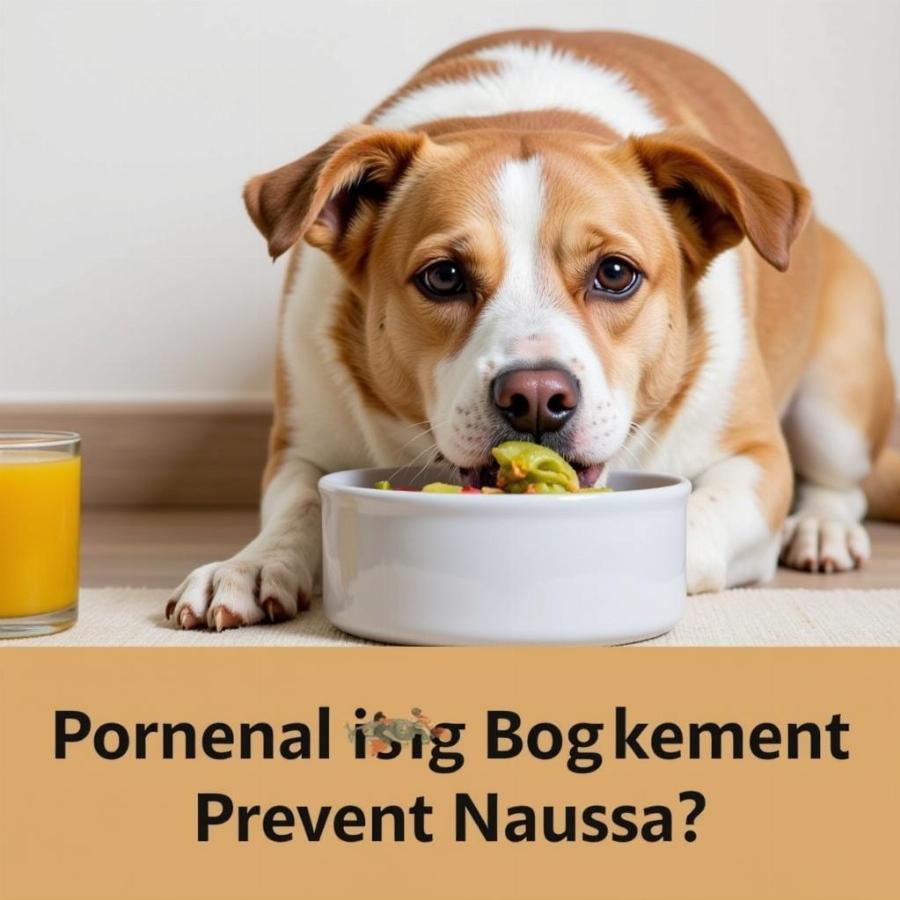Nausea in dogs, while common, can be tricky to detect. Unlike humans, our furry friends can’t tell us when they’re feeling queasy. Understanding the subtle signs of nausea in dogs is crucial for providing timely care and ensuring their well-being. This article delves into the various indicators of nausea, helping you recognize discomfort in your beloved pet and take appropriate action.
Recognizing the Subtle Cues: How to Tell if Your Dog is Nauseous
It’s important to remember that dogs exhibit nausea differently than humans. They might not always vomit, even if they feel sick. Instead, look for a cluster of signs of nausea in dogs, which might include excessive lip licking, swallowing, or drooling. These behaviors often accompany feelings of discomfort in the stomach. Your dog might also appear restless, pacing back and forth, or unable to settle down.
Changes in appetite are another key indicator. A nauseous dog might refuse food, even their favorite treats. They might also show disinterest in activities they usually enjoy. Coupled with these behavioral changes, physical symptoms like dry heaving or retching further suggest nausea. Observing these subtle cues will help you identify potential problems and seek veterinary attention when necessary.
Common Causes of Nausea in Dogs: From Dietary Indiscretions to Serious Illnesses
A variety of factors can contribute to nausea in dogs. Dietary indiscretions, such as scavenging garbage or eating spoiled food, are common culprits. Certain medications, as well as underlying medical conditions like pancreatitis, kidney disease, and infections, can also trigger nausea. how fast do dogs digest food plays a role in how quickly symptoms appear after ingestion of something problematic. Additionally, motion sickness and anxiety can induce nausea in some dogs. Understanding the potential causes helps determine the severity of the situation and guides appropriate treatment.
Is Your Dog’s Nausea a Cause for Concern? When to Seek Veterinary Help
While occasional nausea might resolve on its own, persistent or severe symptoms warrant a trip to the veterinarian. If your dog experiences repeated episodes of vomiting, refuses to eat or drink for more than 24 hours, exhibits lethargy or weakness, or shows other concerning signs like bloody vomit or diarrhea, seek immediate veterinary attention. Early diagnosis and treatment are crucial for managing underlying health issues and preventing complications.
Home Remedies for Dog Nausea: Soothing Your Pet’s Upset Stomach
For mild cases of nausea, some home remedies can help soothe your dog’s upset stomach. Withholding food for a few hours allows the digestive system to rest. Offering small amounts of bland food, like boiled chicken and rice, can help ease nausea. why do dogs smack their lips This behavior, although sometimes linked to nausea, could also indicate other issues. Ensuring your dog has access to fresh water is essential to prevent dehydration. However, consult your veterinarian before administering any over-the-counter medications or home remedies, especially if your dog has pre-existing health conditions. over the counter nausea medicine for dogs should be administered under veterinary guidance.
Can Essential Oils Help with Dog Nausea? Proceed with Caution
While some essential oils, like ginger and peppermint, have shown potential in relieving nausea, it’s crucial to use them with extreme caution in dogs. peppermint essential oil dogs can be toxic if ingested or applied directly to the skin. Always consult with a holistic veterinarian before using essential oils around your pet.
Preventing Nausea in Dogs: Proactive Steps for a Happy, Healthy Pet
Proactive measures can significantly reduce the risk of nausea in your dog. Maintaining a clean environment, free of potential toxins and hazardous substances, is essential. are black eyed susans toxic to dogs Knowing which plants are toxic is important for a safe environment. Storing medications and cleaning products securely, out of your dog’s reach, can prevent accidental ingestion. Feeding a balanced diet and avoiding sudden changes in food can also help maintain digestive health.
 Chó ăn thức ăn lành mạnh
Chó ăn thức ăn lành mạnh
Conclusion: Prioritizing Your Dog’s Digestive Health
Recognizing the signs of nausea in dogs is vital for ensuring their well-being. By understanding the subtle cues, potential causes, and appropriate preventive measures, you can proactively address digestive discomfort in your canine companion. Don’t hesitate to consult your veterinarian if you suspect your dog is experiencing nausea, especially if symptoms persist or worsen. Early intervention is key to maintaining a happy, healthy dog.
FAQ: Common Questions about Nausea in Dogs
- What are the most common signs of nausea in dogs? Excessive lip licking, drooling, swallowing, restlessness, loss of appetite, dry heaving, and retching.
- What can cause nausea in dogs? Dietary indiscretions, medications, medical conditions, motion sickness, and anxiety.
- When should I take my dog to the vet for nausea? If vomiting is persistent, your dog refuses food or water for over 24 hours, shows lethargy, or exhibits other concerning signs like bloody vomit or diarrhea.
- What home remedies can help with dog nausea? Withholding food temporarily, offering bland food, ensuring access to fresh water.
- Can I give my dog over-the-counter nausea medicine? Always consult your veterinarian before administering any medication.